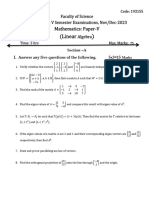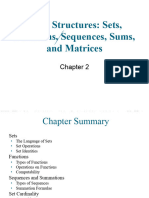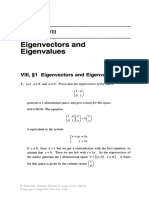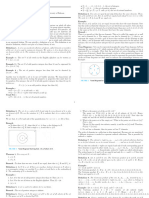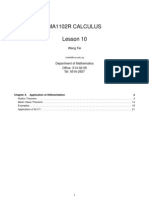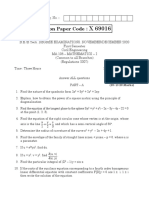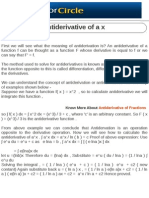Eigenbasis
Eigenbasis
Uploaded by
VidushiCopyright:
Available Formats
Eigenbasis
Eigenbasis
Uploaded by
VidushiOriginal Description:
Original Title
Copyright
Available Formats
Share this document
Did you find this document useful?
Is this content inappropriate?
Copyright:
Available Formats
Eigenbasis
Eigenbasis
Uploaded by
VidushiCopyright:
Available Formats
EIGENBASES
NATHAN GRIGG
Let A be an n × n matrix. An eigenbasis corresponding to A is a basis for Rn
consisting entirely of eigenvectors for A. Such a basis only exists if A is diagonaliz-
able (or not defective). To find an eigenbasis, you find a basis for each eigenspace
of A. The collection of all these basis vectors for an eigenbasis for A.
The fact that you get a basis for Rn is kind of special. Usually, combining two
linearly independent sets doesn’t give you a new linearly independent set, but it does
when each linearly independent set consists of eigenvectors, each set for a different
eigenvalue. You can prove this in pretty much the same way you would prove that
any two eigenvectors that have different eigenvalues are linearly independent.
−83 4 35
Example. The matrix A = −348 20 140 has eigenvalues 3, 4, 4. The
−174 8 74
35 4
eigenspace E4 has a basis 0 , 87 , and the eigenspace E3 has a basis
87 0
1 35 4 1
4 . So an eigenbasis corresponding to A is 0 , 87 , 4 .
2 87 0 2
Exercises.
3 0 −3 1
(1) Find an eigenbasis corresponding to A = 0 3 −3 . Write x = 2
0 0 0 3
as a linear combination of the basis and use this to find A10 x.
0 −1 1
(2) Find an eigenbasis corresponding to A = −1 0 1 . Write x =
1 −1 0
x
y as a linear combination of the basis and use this to find a general
z
formula for At x.
You might also like
- (Steven Galbraith) Mathematics of Public Key CryptDocument597 pages(Steven Galbraith) Mathematics of Public Key CryptN Anil Kumar100% (1)
- EigenbasisDocument1 pageEigenbasisohnoitsgabeNo ratings yet
- 1 ProbToolsDocument89 pages1 ProbToolsLuca RampoldiNo ratings yet
- Advanced Calculus Book 1 by David FearnleyDocument178 pagesAdvanced Calculus Book 1 by David FearnleyasdfghNo ratings yet
- Eigenvalues and EigenvectorsDocument10 pagesEigenvalues and Eigenvectorskalyangofredrick742No ratings yet
- Cs5002 Lect4 Fall18 Notes BlankDocument20 pagesCs5002 Lect4 Fall18 Notes BlankRuby PoddarNo ratings yet
- Edward Penney Matrix SystemsDocument13 pagesEdward Penney Matrix Systemsluigi.cumabigNo ratings yet
- Linear Algebra with Applications 2nd Edition Holt Test Bank download pdfDocument39 pagesLinear Algebra with Applications 2nd Edition Holt Test Bank download pdfgrasinabawy100% (4)
- Get Linear Algebra With Applications 2nd Edition Holt Test Bank Free All Chapters AvailableDocument50 pagesGet Linear Algebra With Applications 2nd Edition Holt Test Bank Free All Chapters Availablekobangnikels100% (1)
- Probability Book PDFDocument185 pagesProbability Book PDFRaya OdehNo ratings yet
- Sem V - Linear AlbegraDocument2 pagesSem V - Linear AlbegranavalchowkeNo ratings yet
- Chap.5 Eigenvalues EigenvectorsDocument34 pagesChap.5 Eigenvalues EigenvectorsndarubagusNo ratings yet
- Proprep - Linear Algebra - Eigenvectors Eigenvalues and Diagonalization - WorkbookDocument16 pagesProprep - Linear Algebra - Eigenvectors Eigenvalues and Diagonalization - WorkbookDhanush ReddyNo ratings yet
- Homework 1Document2 pagesHomework 1tanay.s1No ratings yet
- DM Unit 1Document30 pagesDM Unit 1Rushikesh ShindeNo ratings yet
- La Medida-2Document11 pagesLa Medida-2Harold AponteNo ratings yet
- Supplement (Set Theory)Document5 pagesSupplement (Set Theory)Raman SarabhaNo ratings yet
- Sets and Cardinality Notes For 620-111: C. F. Miller Semester 1, 2000Document21 pagesSets and Cardinality Notes For 620-111: C. F. Miller Semester 1, 2000DarKevin PerillaNo ratings yet
- Stat6201 ch1-2Document2 pagesStat6201 ch1-2BowenYangNo ratings yet
- Principal Component Analysis: C Harvard Math 21bDocument3 pagesPrincipal Component Analysis: C Harvard Math 21bEmily LiuNo ratings yet
- Chapter 2Document145 pagesChapter 2canglah1108No ratings yet
- HW 7Document1 pageHW 7Kathy LeeNo ratings yet
- Further Mathematical Methods (Linear Algebra) 2002 Problem Sheet 2Document2 pagesFurther Mathematical Methods (Linear Algebra) 2002 Problem Sheet 2Gag PafNo ratings yet
- Supplement (Set Theory)Document5 pagesSupplement (Set Theory)mac as macNo ratings yet
- Typed Notes - Real AnalysisDocument48 pagesTyped Notes - Real Analysispravankarjog12345678No ratings yet
- Worksheet 1Document2 pagesWorksheet 1David PattyNo ratings yet
- 10700121101 - CopyDocument6 pages10700121101 - CopyAyan SahaNo ratings yet
- MathematicsDocument1 pageMathematicsShajenx CleofeNo ratings yet
- Measure Theory FullDocument61 pagesMeasure Theory Fullcontentisking69No ratings yet
- Measure TheoryDocument141 pagesMeasure TheoryLuca RampoldiNo ratings yet
- Math SetsDocument1 pageMath SetsPutungan AnsherinaNo ratings yet
- 2002 Cambridge ExamDocument22 pages2002 Cambridge ExamRoss WrightNo ratings yet
- Linear 8Document2 pagesLinear 8j90386544No ratings yet
- M 290 Not Esch SevenDocument19 pagesM 290 Not Esch SevenAli ImranNo ratings yet
- 4.eigenvalues and Eigenvectors and DiagonalizationDocument7 pages4.eigenvalues and Eigenvectors and Diagonalizationdasithpramuditha2No ratings yet
- Dictionary New OneDocument547 pagesDictionary New Onegurmeet0% (1)
- 【工程中的矩阵理论】习题答案整理Document9 pages【工程中的矩阵理论】习题答案整理foo-hoat LimNo ratings yet
- Topic06 SetsDocument14 pagesTopic06 SetsaakashbarotNo ratings yet
- Math ReviewerDocument6 pagesMath ReviewerPutungan AnsherinaNo ratings yet
- Dan Sloughter - A Primer of Real Analysis-Furman University, LibreTextsDocument161 pagesDan Sloughter - A Primer of Real Analysis-Furman University, LibreTextsMeetali RamchandaniNo ratings yet
- Homework 3 Problem 1: Eigenvalue ProblemDocument5 pagesHomework 3 Problem 1: Eigenvalue Problem沈智恩No ratings yet
- Eigenvalue and EigenvectorsDocument8 pagesEigenvalue and Eigenvectorsmahmood mohammadNo ratings yet
- Lecture 5Document7 pagesLecture 5Mann MalviyaNo ratings yet
- Ch05 NotesDocument6 pagesCh05 NotesKaneNo ratings yet
- 10A - Review and Problem SolvingDocument6 pages10A - Review and Problem SolvingNIDHINo ratings yet
- Assignment 3 MA 407 - 607Document1 pageAssignment 3 MA 407 - 607harshitkhokhani34No ratings yet
- Discrete Mathematical Structures 15CS3 6: Set TheoryDocument34 pagesDiscrete Mathematical Structures 15CS3 6: Set TheoryShruti LadageNo ratings yet
- Introduction To Sets and FunctionsDocument6 pagesIntroduction To Sets and FunctionsChuuNo ratings yet
- CSC102Document29 pagesCSC102codedynamics24No ratings yet
- Discreate MathematicsDocument137 pagesDiscreate Mathematicsareeba tariqNo ratings yet
- Introduction To Mathematical AnalysisDocument141 pagesIntroduction To Mathematical AnalysisDuende6850% (4)
- Module 2 Eigen Values and Eigen Vectors, DiagonalisationDocument139 pagesModule 2 Eigen Values and Eigen Vectors, DiagonalisationSanskriti GuptaNo ratings yet
- Unit 3 DMSDocument14 pagesUnit 3 DMSshubhamNo ratings yet
- Chapter 5 - SetsDocument5 pagesChapter 5 - Setshassoon221 / حسوون٢٢١No ratings yet
- Lesson 6 Eigenvalues and Eigenvectors of MatricesDocument8 pagesLesson 6 Eigenvalues and Eigenvectors of Matricesarpit sharmaNo ratings yet
- XI Maths SETS Remesh HssliveDocument5 pagesXI Maths SETS Remesh HssliveMidhun Raj SNo ratings yet
- Chapter 5 - Eigen VectorDocument12 pagesChapter 5 - Eigen VectorLEE LEE LAUNo ratings yet
- Exercise Set 5.1: Concept ReviewDocument7 pagesExercise Set 5.1: Concept ReviewBabasrinivas GuduruNo ratings yet
- Dbms Lab File: Submitted To: DR Parul TomarDocument26 pagesDbms Lab File: Submitted To: DR Parul TomarVidushiNo ratings yet
- Assignment: Name: Vidushi Tickoo Roll No: 18001003131Document2 pagesAssignment: Name: Vidushi Tickoo Roll No: 18001003131VidushiNo ratings yet
- Lab Test 18001003131 DBMSDocument3 pagesLab Test 18001003131 DBMSVidushiNo ratings yet
- Handwritten Original Signature and Forged Signature Classifier - Vidushi TickooDocument6 pagesHandwritten Original Signature and Forged Signature Classifier - Vidushi TickooVidushiNo ratings yet
- COI ASSIGNMENT VidushiDocument7 pagesCOI ASSIGNMENT VidushiVidushiNo ratings yet
- 04 - Solving Linear Systems With Technology Teacher NotesDocument2 pages04 - Solving Linear Systems With Technology Teacher Notesapi-288090607No ratings yet
- University Institute of Engineering and Technology M. D. University, RohtakDocument5 pagesUniversity Institute of Engineering and Technology M. D. University, Rohtaksinghyuvi2050No ratings yet
- Chapter 2-MMWDocument40 pagesChapter 2-MMWCarlaMaeMaquirangNo ratings yet
- Linear Algebra Coursebook 2021-2022 - University of Twente - Lecture NotesDocument154 pagesLinear Algebra Coursebook 2021-2022 - University of Twente - Lecture NotesMaria Elena RiusNo ratings yet
- Algad 2Document22 pagesAlgad 2k8vbrk7p5pNo ratings yet
- Test of Understanding of Vectors: A Reliable Multiple-Choice Vector Concept TestDocument14 pagesTest of Understanding of Vectors: A Reliable Multiple-Choice Vector Concept TestfaniNo ratings yet
- TrinMaC Virtual Winter 2023 ProblemsDocument6 pagesTrinMaC Virtual Winter 2023 Problemsnunya78No ratings yet
- Composite and Inverse FunctionsDocument12 pagesComposite and Inverse FunctionsAnonymous yPCsBWJG9No ratings yet
- IBL AbstractAlgebra2019 PDFDocument114 pagesIBL AbstractAlgebra2019 PDFAnother numberNo ratings yet
- Ma1102R Calculus Lesson 10: Wang FeiDocument14 pagesMa1102R Calculus Lesson 10: Wang FeidelsonwiestNo ratings yet
- Grundlehfen Def Mathematischen Wissenschaften 290: A Series of Comprehensive Studies in MathematicsDocument690 pagesGrundlehfen Def Mathematischen Wissenschaften 290: A Series of Comprehensive Studies in MathematicsJuanMiguel100% (4)
- Question Paper Code: Reg. No.Document3 pagesQuestion Paper Code: Reg. No.gangadharan tharumarNo ratings yet
- Fractions - Comparing - 3 Methods - Grade 3Document3 pagesFractions - Comparing - 3 Methods - Grade 3thegomomNo ratings yet
- Chapter 4 Matricesaa-Answer-Key-pdf-4Document29 pagesChapter 4 Matricesaa-Answer-Key-pdf-4umkaurkNo ratings yet
- Cyclic Codes: Saravanan Vijayakumaran Sarva@ee - Iitb.ac - inDocument25 pagesCyclic Codes: Saravanan Vijayakumaran Sarva@ee - Iitb.ac - insharukhsshaikhNo ratings yet
- Anti Derivative of A XDocument3 pagesAnti Derivative of A XnishagoyalNo ratings yet
- Me16A: Chapter Four: Analysis of Stresses in Two DimensionsDocument31 pagesMe16A: Chapter Four: Analysis of Stresses in Two Dimensionsank_mehra100% (1)
- Writing Linear Equation From Standard Form To Slope - Intercept and Vice VersaDocument38 pagesWriting Linear Equation From Standard Form To Slope - Intercept and Vice VersaMa. Rica Mae RoseteNo ratings yet
- 28 Arithmetic and Geometric Sequences Practice Homework w3rmk9Document4 pages28 Arithmetic and Geometric Sequences Practice Homework w3rmk9audie mataNo ratings yet
- Jabatan Pendidikan Negeri PerakDocument18 pagesJabatan Pendidikan Negeri PerakRossniePijieNo ratings yet
- 4PM1 01R MSC 20210211Document24 pages4PM1 01R MSC 20210211Little Wizard100% (1)
- Quantum Groups A Path To Current Algebra 1st Edition Ross Street 2024 Scribd DownloadDocument84 pagesQuantum Groups A Path To Current Algebra 1st Edition Ross Street 2024 Scribd Downloadgurpdainis75100% (4)
- Module 02 Lesson 03 - Derivatives of Trigonometric Functions (With Limits)Document16 pagesModule 02 Lesson 03 - Derivatives of Trigonometric Functions (With Limits)Kiziahlyn Fiona BibayNo ratings yet
- Factor Flow Chart PDFDocument7 pagesFactor Flow Chart PDFsomenathbasakNo ratings yet
- A - Cardinal - Function - Algorithm - For - Computing - MultivDocument13 pagesA - Cardinal - Function - Algorithm - For - Computing - MultivThiago NobreNo ratings yet
- Wigner-Eckart Theorem: Q K J J J K J M M Q KDocument6 pagesWigner-Eckart Theorem: Q K J J J K J M M Q KAtikshaNo ratings yet
- An Example of Double Cross Coproducts With Non-Trivial Left Coaction and Right Coaction in Strictly Braided Tensor CategoriesDocument33 pagesAn Example of Double Cross Coproducts With Non-Trivial Left Coaction and Right Coaction in Strictly Braided Tensor Categoriesjsdmf223No ratings yet
- FEM&BestpracticesDocument293 pagesFEM&BestpracticesHem ANo ratings yet
- Factoring Polynomials With Common Monomial FactorDocument31 pagesFactoring Polynomials With Common Monomial FactorShawn MikeNo ratings yet










